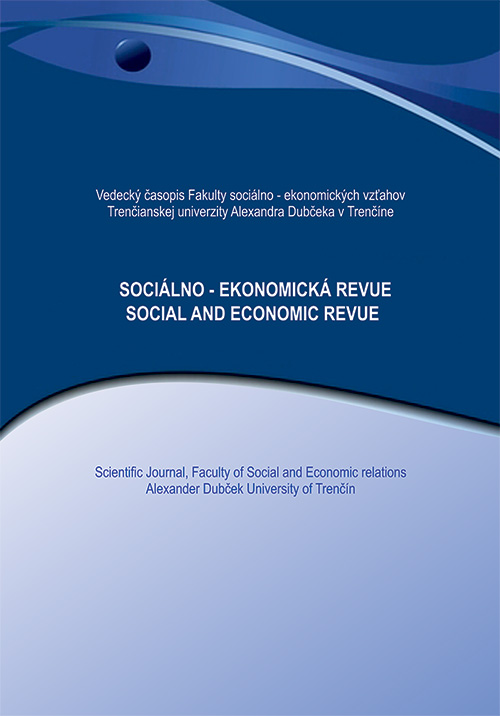THE INFLUENCE OF INSTITUTIONAL FACTORS ON ECONOMIC GROWTH
Economic growth and the associated standard of living are among the most significant, watched and discussed topics of the general public. For that reason, it is the subject of many economists, scientific literature, and economic models. Opinions about the causes of growth, but also stagnation, of the world's economies vary, whether within economic flows, theories or among economists themselves. Increasingly, it refers to the reduced ability of known theories to answer all the causes of economic differences between seemingly similar countries. One of the modern explanations of the differences between the world's economies is that of the so-called institutional factors of economic development - culture, religion, history, geography, or political regime. Therefore, this research paper analyses the relationship between economic growth and institutional factors of development. In the context of the influence of institutional factors on economic growth, democracy assumes that political competition allows voters to use the state as a source of redistribution. Thus, if the average voter is lower than the average, middle-income and low-income citizens can determine the election result and thus claim higher tax rates for the rich.
Vydanie: 2019/1 Strany: 11-23 Klasifikácia JEL: A13, O4, O10
DOI:
Kľúčové slová: Cohesion, Convergence, Economic Growth
Sekcia: ECONOMICS AND ECONOMY
Kontakty:
PhDr. Martin Hudec, MBA, PhD.
University of Economics in Bratislava
Faculty of Commerce, Department of Marketing
Dolnozemská cesta 1
Bratislava, 852 35
Slovak Republic
e-mail: mhudec18@gmail.com, martin.hudec@euba.sk
Literatúra:
Arestis, P., Demetriades, P. (1994). Finance and growth: Institutional Considerations and Causality, Working Papers 9605, University of East London, Department of Economics.
Barro, R. J., Sala-i-Martin, X. I. (2003). Economic Growth. Cambridge: The MIT Press, 672
Calvo, G. A. (2006). Money, Exchange Rates, and Output. Cambridge: The MIT Press, 532
Casasnovas, G. L., Rivera, B., Currais, L. (2007). Health and Economic Growth: Findings and Policy Implications. Cambridge: The MIT Press, 400
Cline, W. (2010). Financial Globalization, Economic Growth, and the Crisis of 2007-09. Washington, D.C.: Peterson Institute for International Economics, 362
Dalziel, P., Saunders, C., Saunders, J. (2018). Wellbeing Economics: The Capabilities Approach to Prosperity. Leeds: Palgrave Macmillan, 196
Daly, H. E. (2012). Steady-State Economics. Washington, D.C.: Island Press, 320
Emerson, J. (2018). The Purpose of Capital: Elements of Impact, Financial Flows, and Natural Being. San Francisco: Blended Value Group Press, 362
Galetovic, A. (1994). Finance and Growth: A Synthesis and Interpretation of the Evidence. International Finance Discussion Papers 477, Board of Governors of the Federal Reserve System.
Grandville, O. (2016). Economic Growth: A Unified Approach. Cambridge: Cambridge University Press, 448
Gregorio, J., Guidotti, P. E. (1995). Financial Development and Economic Growth. World Development, 23(3), 433-448.
Grinin, L., Korotayev, A., Tausch, A. (2018). Economic Cycles, Crises, and the Global Periphery. Basel: Springer, 284
Hollyer, J. R., Rosendorff, B. P., Vreeland, J. R. (2018). Information, Democracy, and Autocracy: Economic Transparency and Political (In)Stability. Cambridge: Cambridge University Press, 396
Hori, H. (2017). Business Cycle Dynamics and Stabilization Policies: A Keynesian Approach. Singapore: Springer, 142
Index of Economic Freedom. (2018): Country Rankings. [on-line]. [acc.: 2018-12-26]. Retrieved from: https://herit.ag/2Db8NeT.
Johansen, S. (1996). Likelihood-Based Inference in Cointegrated Vector Autoregressive Models. Oxford: Oxford University Press, 290
Jones, Ch. I., Vollrath, D. (2013). Introduction to Economic Growth. New York: W. W. Norton & Company, 320
Kapp, K. W. (2014). The Foundations of Institutional Economics. New York: Routledge, 300
Kasper, W., Streit, M. E., Boettke, P. J. (2013). Institutional Economics. Northampton: Edward Elgar, 608
Knoop, T. A. (2015). Business Cycle Economics. San Barbara: Praeger, 391
Kawana, T., Hazama, Y. (2016). Political Determinants of Income Inequality in Emerging Democracies. Singapore: Springer, 112
Lewis, W. A. (2003). Theory of Economic Growth. New York: Routledge, 456
Moore, B. (2018). Moral Aspects of Economic Growth, and Other Essays. New York: Cornell University Press, 200
North, D. C. (1991). Institutions, Institutional Change and Economic Performance. Cambridge: Cambridge University Press, 159
Reimers, H. E. (1992). Comparison of Tests for Multivariate Cointegration. Statistical Papers, 33(1), 335-359
Romer, D. (2018). Advanced Macroeconomics. Berkeley: McGraw-Hill Education, 715
Shimer, R. (2010). Labor Markets and Business Cycles. New Jersey: Princeton University Press, 192
Tucker, I. B. (2018). Survey of Economics. Boston: Cengage Learning, 592
Voigt, S. (2009). Institutionenökonomik: Neue Ökonomische Bibliothek. Stuttgart: UTB GmbH, 287
Wachtel, P., Rousseau, P. (1994). Financial Intermediation and Economic Growth: A Historical Comparison of the U.S., U.K. and Canada. Working Papers 94-04, New York University, Leonard N. Stern School of Business, Department of Economics.
Weil, D. (2012). Economic Growth. New York: Routledge, 586


